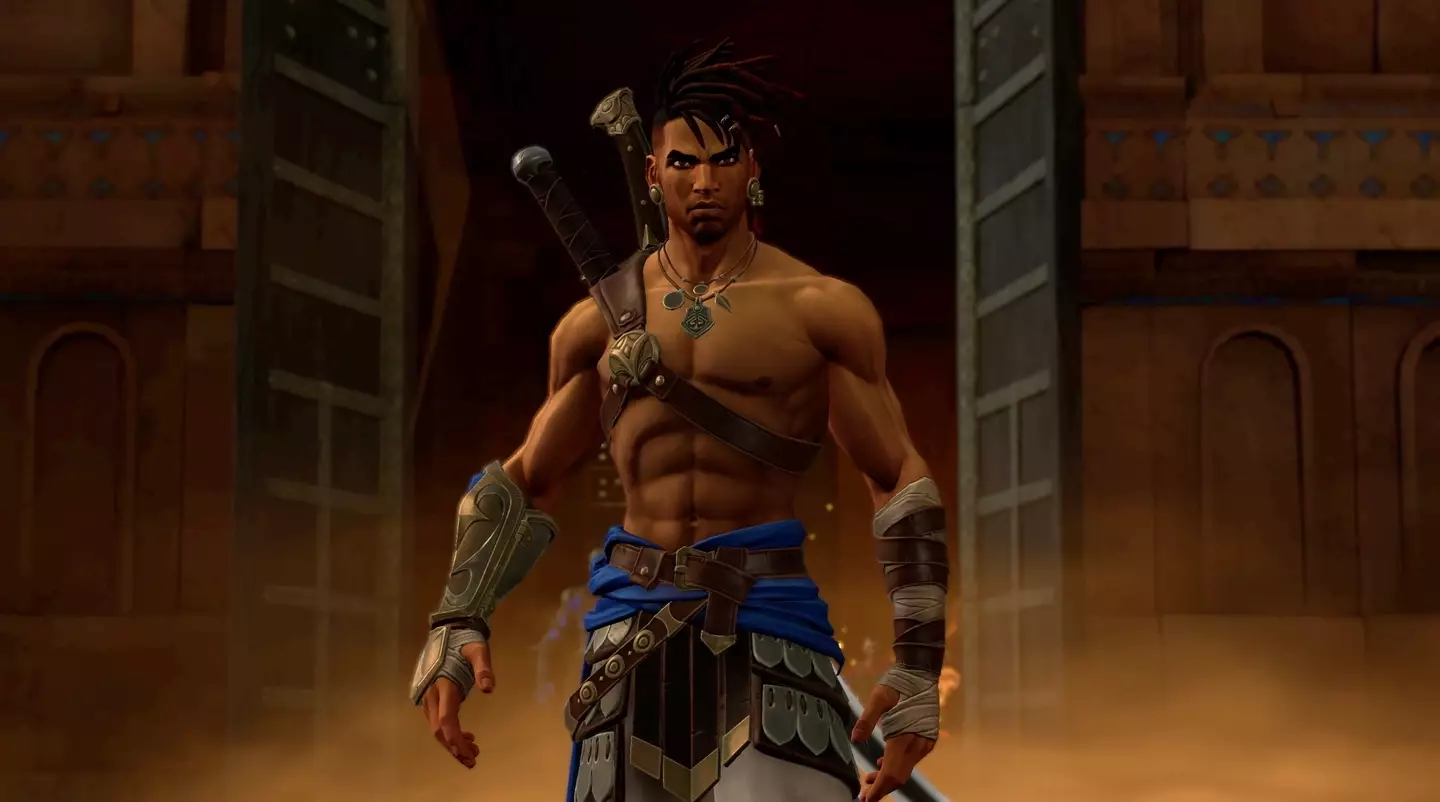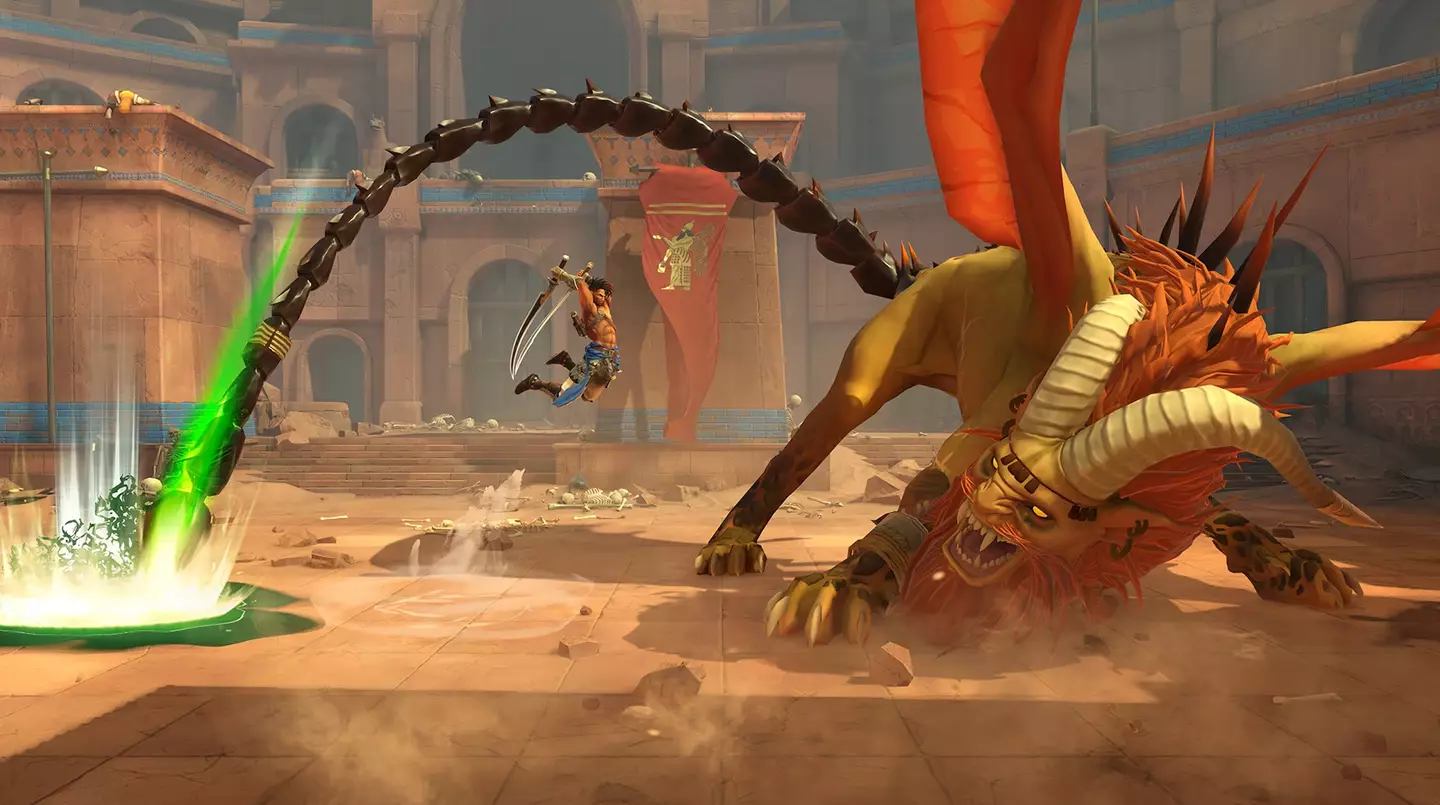
My time with Prince of Persia: The Lost Crown felt like it was over too soon. We had three hours to play through the game from its dramatic opening of betrayal and intrigue to a point where mystical powers and abilities began to open up the MetroidVania 2D world. But I wanted more, which is surely a good sign, right? Three hours was just enough time to teach me the ropes while still dangling possibilities.
Taking control of Sargon, players will be making their way through Mount Qaf on the hunt for rebels who have kidnapped Prince Ghassan. Sargon, a member of a group of heroes called The Immortals, must use his parkour skills and deadly efficiency with a blade to save the Prince. However, things on Mount Qaf aren’t what they seem and pockets of the environment seem to be having an impact on the passage of time.
Prince of Persia is going back to its 2D roots with The Lost Crown.
While you could compare this new instalment in the Prince of Persia series to many games, including the original 1989 release, it probably has a closer cousin in games like Hollow Knight and Salt and Sacrifice. This isn’t just because of the game’s new MetroidVania exploration, but also because of its combat.
Advert
It’s easy to say the game’s difficulty level starts pretty high, but it would paint the game in the wrong light. After all, difficulty in games is subjective, plus Ubisoft has done a lot on the accessibility front allowing players to shape the difficulty of the game themselves. For example, there are options to change the window in which you can parry attacks, or you can reduce the combat difficulty of enemies, by changing it on the fly.
The difficulty stands out in the biggest boss fight of the opening hours, a huge winged and horned lion-like creature with a scorpion tail called Jahandar. In this boss fight I was frantically dodging, sliding, parrying, and wielding my twin blades in the hopes of besting the beast. It didn’t go well for me. After 10 or 11 attempts I finally overcame the challenge and got to move on, but, I will admit I didn’t get good fast enough and opened the parry window for my old fingers to finally achieve success.
The fight shows a lot of mechanics and features of the game. Each parry is rewarded with a lavish take-down; the fight was split into stages where Jahandar would evolve its attacks; and dying has you backtrack through the maze of platforms and sections every time ending up back at a checkpoint. These checkpoints, glorious trees made of light, will also refill your health potions, so you could say there are some very light SoulsBorne mechanics, too. More on these trees later.

This backtracking isn’t as painful as it sounds, however, as the map is not only pretty comprehensive, showing you, via icons, where you need to go, but there’s a genius inclusion that will help out many. If you come across a chest or door you can’t reach, a simple button press will take a screenshot of it and place it on your map. No more trying to remember where you saw it!
Advert
It’s also a big plus that traversing feels brilliant. The parkour movement, which includes sliding, wall-jumping, and later, air-dashing, makes each section of the map a joy. When combined with Prince of Persia mainstays like poles on which to swing, spike traps to dodge, and swinging pendulums to slide under, the world of Mount Qaf becomes a playground. The ground slide in particular becomes a ‘go to’ movement because it not only dodges you under obstacles but you can use it to pop up behind enemies and attack.
The map is broken down into sections with a particular theme. I got to see a few and the one that stood out for me was a library area with magical staircases - not quite Potter-esque - as these move depending on the direction you’re facing, changing your paths up and down based on what Sargon is looking at. While it’s not quite a puzzle, it takes some brain power to find your way through, especially when being chased by teleporting enemies.
The game is not only inspired by the original trilogy from the 1990s but also the Sands of Time trilogy from the Xbox 360 and PlayStation 3 era. So, it doesn’t take long for the first of the mystical abilities to make an appearance - a delightful airdash that bridges gaps to hard-to-reach areas. While I didn’t get to see any time manipulation in my time with the game, it is ever present as sometimes you’ll meet up with other members of The Immortals for them to express being lost for days, while for us it’s been mere hours. This timey wimey oddness also appears in bizarre balls of energy which, when struck, change the positioning of platforms and structures to a former position, allowing for further exploration.

A slight detractor from the session was the voice acting. Some of it felt very stilted and oftentimes a little bland, too. However, the development team went to lengths to tell us that Farsi was included for more authenticity, and switching to that honestly changed up the cutscenes dramatically.
Advert
In other areas the game shone bright; the visuals are a treat, with bright colours, sparkling auras, comic book-style graphics, and larger-than-life enemy design that taps into wondrous parts of mythology. At points, the visual design is startlingly good, particularly when entering into new areas.
Now, before I wrap up this preview, let’s go back to those trees which for many will come to symbolise bonfires in Dark Souls, a place where your healing is refreshed and you’ll spawn when you die, but also a place to change amulets, which give bonuses to Sargon, but you’ll also be able to choose Athra Surges, which are high damage attacks or can conjure patches of light in which to heal. These, paired with quick travel points that can lead to market stalls and a forge for buying items and upgrading your weaponry, make the game feel a lot like an RPG.
This is a lot of words to say that a lot is going on in Prince of Persia: The Lost Crown and it all somehow manages to compliment each aspect rather than overwhelm, which it could have easily done. So, while stylistically it looks like its 1989 originator, it plays like a very modern MetroidVania filled with RPG elements to make your playthrough feel unique, and one that will hopefully shine in a field that becomes more crowded each month.
Featured Image Credit: UbisoftTopics: Preview, Prince Of Persia, Ubisoft
